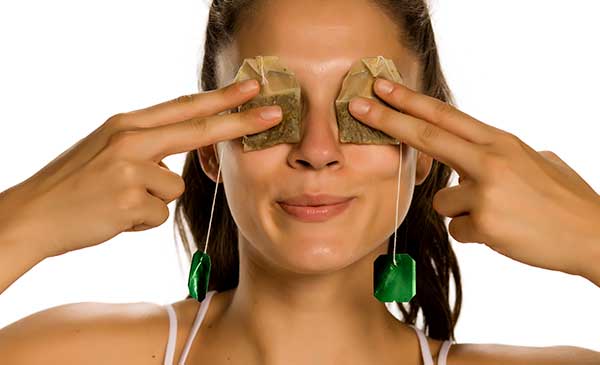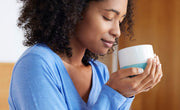I finally found a use for tea bags!

We probably all have them...those grocery store-bought tea bags that you didn't like, but never tossed out. It's no surprise really that the bags are sitting in your pantry - the flavor just doesn't compare to the flavor of loose leaf tea!
The leaves in most tea bags are actually the 'dust and fannings' of broken tea leaves. And old leaves at that! Produced in huge batches, tea bags often sit on store shelves for years before they made it to your pantry (to sit even longer). These fine tea leaves when steeped release more tannins than loose leaf tea, resulting in a bitter or astringent cup of tea. And who likes that?
But I finally found a use for those tea bags in the pantry!
Put tea bags on eyes to reduce eye puffiness
When we don't get the right amount of sleep our body needs, it can show on our face. Dark circles, puffy bags, or redness are the tell tale signs we need more sleep. But when you can't crawl back into bed for a few more z's, tea bags may help reduce dark circles, puffiness, and redness.
Tea bags may also help to ease eye irritation, styes, and pink eye. Tea bags are a natural option that you can easily do at home. The tannin in tea acts as an anti-inflammatory while lifting the fluid build up, tightening the skin, and reducing swelling and discoloration.
Follow these steps to reduce dark circles and bags under your eyes:
- Steep two tea bags in hot water.
- Squeeze the tea bags to release the liquid.
- Wait for them to cool down slightly.
- Place the tea bags over your closed eyes for up to 15 minutes.
- Repeat as needed.
Drinking tea has many benefits for your skin, but tea can also be absorbed topically in your bath.

Use tea bags to make the best tea bath
Add tea bags directly to your bath, or brew a pot of strong tea and add it to your bathwater. Using tea in your bath can help to infuse your bathwater with antioxidants while also reducing inflammation and helping to balance your skin's pH. And your bathroom will smell great.
There are a few ways to prepare your tea bath, but the easiest way is to have your tub filled with hot (not scalding) water and let about six tea bags steep in it before you get in.
Super hot water is not good for your skin, so don't run the water too hot! If you do, let the tea bags steep while it cools down, or run a more moderate temperature bath and keep the tea bags in for a bit longer.
The tea bags floating around may not exactly replicate the floating rose petals from your last spa experience, so if you have more time, brew a pot of tea first, and let it steep for about 10 minutes. While the tea is steeping, fill your hot bath, and pour the tea in once it’s ready. Test the water, and add some cool water to your personal preference.
What tea to use in your tea bath
Before you dive in, consider which tea bath benefits you are looking for and it will help you select which health-promoting tea to soak in:
Green Tea Bath
Green tea is antioxidant-rich and a great detoxifier when drinking or applying straight to your skin. Soaking in it allows all those healthy nutrients to be directly absorbed through your skin and can have beautiful anti-aging effects, helping your skin to recover from environmental irritants. If you want to sweat out toxins, green tea should be your first pick. If your muscles are sore after working out or you're just looking for relief from nagging aches and pains, a green tea soak can help relax them. Green tea also contains a lot of vitamin B, which will make your skin feel silky smooth and soft, helping to relieve any redness.
Black Tea Bath
Black tea helps to reduce inflammation and relaxes irritated muscles. The tannins in black tea are also extremely cleansing and help soothe your skin and reduce pores if you deal with body acne. Black tea helps speed up the body’s healing process, so a good soak can help relieve itchy skin if you have irritations, sunburn, or if you're suffering from bug bites. (Just be sure to give your tub a good scrub after to avoid stains to your tub.)
Herbal Tea Bath
Herbal tea blends can also help sweat out toxins and relieve muscle tension, as well as calm your nerves, stimulate circulation, and rejuvenate your skin. Using a hot bath to sweat out toxins can make you feel a bit lightheaded, so be sure to hydrate before and after your bath.
Chamomile Tea Bath
For a glowing complexion, chamomile tea can do wonders. It’s stress-relieving like other herbal teas and also a good tea for a restful night, so try a chamomile bath before bed.
Peppermint Tea Bath
If you're down with a cold, this bath will help clear your sinuses and ease congestion. Peppermint tea can also help to reduce inflammation, soothe burned or irritated skin. Sprinkle in some epsom salts to create an incredibly detoxifying bath The mint scent can also help elevate your mood, so if you're suffering from the SIP blues, a minty bath may be just what you need!
Lavender Tea Bath
When you absolutely need to de-stress, this floral tea provides a relaxing aroma. Blend in some peppermint tea to help ease a headache from the long day you're trying to put behind you. If you don't have lavender tea in the cabinet, you can substitute dried lavender buds and blend with epsom salts or other teas such as white or black for a good soak.
Jasmine Tea Bath
Many green teas are blended with jasmine, so you can reap the benefits of both in your bath! Jasmine tea can help moisturize dry skin and may even help reduce the appearance of stretch marks. High-stress levels can cause weight gain either due to overeating due to stress, or because stress causes you to just grab the easiest meal, ignoring the nutritional value. Stress can also cause a general slow down of your internal engine because it is focusing on combatting the stress. When the engine slows, so does the calorie burn. The scent of jasmine in your bath has a calming effect which can help decrease your stress level, and avoid the negative effects stress can put on your body.
Rose Tea Bath
Just like other herbal teas, rose tea can calm nerves and is full of antioxidants. But the best beauty secret about rose tea is it can help tighten your pores without drying out your skin like a toner. Full of vitamins A and E, rose tea helps to hydrate and tighten skin reducing the appearance of lines and diminishing dark circles. In fact, rose petals or rose hips are the main ingredients in numerous skincare products. So go ahead, sink down, and refresh your face.
Results
Here are some results from others that have tried a tea bath:
- It was quick, easy, and all-natural
- Left skin feeling silky soft
- Gave skin a more clear appearance with an even tone
- Body felt very relaxed
- Hair felt silky as if it had just been conditioned. (Hair was dipped and allowed to soak in the tub for the last 10 minutes once the water was cooled down.)
- Relieved tension in the body and skin
Studies have also shown a tea bath may:
- Detoxify the skin
- Delay the aging of skin cells and rejuvenate
- Help heal wounds or sunburn
- Reduce any inflammation
- Reduce dandruff and improve Psoriasis
- Fight free radicals
So go ahead, steep yourself a delicious cup of loose leaf tea and put those pantry-space-stealing tea bags to use in your tub!
Cautions:
Those that chose a black tea soak experienced a caffeine effect as it was absorbed through the skin. Not to be recommended before bedtime. Plus, black teas may stain your tub as well as your skin. Having to scrub the tub after your soak may give an abrupt ending to your spa experience...
References:
www.integrativelongevity.org/blog/the-benefits-of-tea-baths
www.naturesbathbody.com/blogs/news/83590593-david-lee-naturals-all-natural-bath-tea
https://www.earthsfriends.com/jasmine-tea-benefits/





